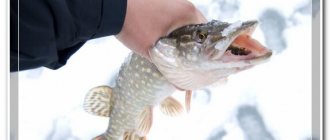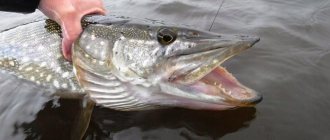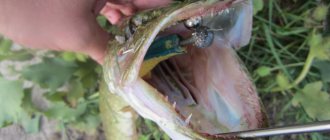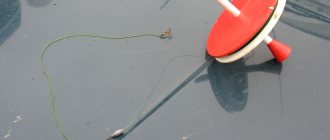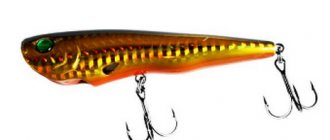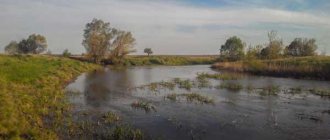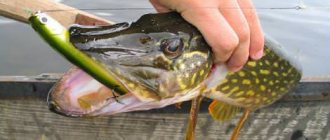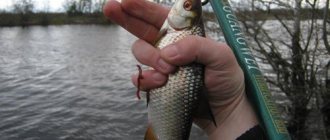how to catch pike with nets
My friends and I are planning to go fishing for pike, but we want to catch this fish with nets.
I would like to know if anyone has managed to catch pike with nets and how to catch pike in this way. In our waters there is no other predatory fish for which so many ingenious methods have been invented and so many artificial baits have been developed. If you carefully examine the entire arsenal of fishing accessories sold, then every third one will turn out to be intended specifically for pike fishing. Moreover, pike often take highly specialized baits that are clearly not designed for it.
And although such bites, if the angler is not ready for them, end in a bite of the fishing line and a spoiled mood, they, without a doubt, fuel interest in fishing and introduce an element of unpredictability into it. During the zhora period, the predator grabs almost everything that even remotely resembles a fish, frog or waterfowl chick.
KNOWLEDGE OF PIKE HABITS IS A GUARANTEE OF SUCCESSFUL FISHING One species of formidable predator evokes admiration for its natural strength and beauty. And the open mouth of a large specimen, framed by fangs and strewn with a brush of needle-shaped teeth driven inside the mouth, is somewhat reminiscent of a wolf. Pike is an ardent individualist. Having reached a certain age, it takes its specific place in the reservoir and “masters” its territory. The pike begins to live separately, not yet gaining 50 g of weight. But if there is too high a concentration of pike in a reservoir , competition arises between them. In this case, the search for your place is delayed for an unlimited period. The best, promising areas of the reservoir are occupied by older specimens, so juvenile pike inhabit the coastal strip. Usually she chooses places near reeds with a favorable microclimate, that is, sufficient flow and a high content of oxygen dissolved in the water. Natural shelter for pikes are snags or grassy vegetation.
The concentration of fish in such an area is high. Fishing here can be very effective, and the bite can last throughout the day. But specimens will rarely reach a weight of 500-600 g. The coastal zone also has its most favorable places, and the competition for them is so great that sometimes it seems that pikes line up to occupy them. From one or two holes you can often catch as many fish as from all the others combined. Pike, having gained the required weight, as a rule, tend to settle in deep snags, the edges of flooded ravines, holes with weak currents, that is, they go into the depths, where they reach impressive sizes. Deep pikes are distinguished by their slab-like, tightly knit body, slightly flattened on the sides.
The dimensions of the body of individual specimens at first glance create the impression of proportion, which, however, is typical for all predatory fish that spend most of their time at sufficient depth. As a rule, it is from this pike “breed” that real giants grow, weighing up to 10 kilograms or more. In contrast to this type of pike, there are individuals whose length greatly dominates their width. They live and forage, as a rule, in the dense vegetation of overgrown reaches. Their serpentine body helps them freely move through the jungle of underwater flora. At Low concentration, although such pikes are inferior in weight to deep ones, they are capable of reaching considerable sizes. As a rule, they smell like mud and are completely inferior to their deep-seated counterparts in gastronomic terms. Some pikes, unable to withstand the fierce competition, remain in charge of the coastal edges near the reeds. Usually they are of little interest to anglers, since they do not reach a decent weight.
In fishing folklore they are called “grass fish”. The territory they occupy is quite limited, and moreover, it has to be shared with other similar specimens. Instead of actively feeding, they are forced to stand in ambush for days, since there is not enough food supply for everyone in a small area. Each pike has its own shelter, its own route, which is a certain closed circuit. The more favorable the weather and seasonal conditions, the longer the route. With a large concentration of predators, several large pikes can live in one snag. During the feast or under certain weather conditions, they come out to the nearest sandbank and can attack live bait almost simultaneously, which creates the illusion of a school of pike. The predator, which has reached a weight of 5 kg, rarely tolerates competitors close to itself and keeps them at a decent distance.
Such a predator will never hunt on a sandbank far from the pit. Pike most often attacks from its usual hiding place, setting up an ambush there. But under favorable conditions or in the absence of food, it, hiding behind the folds of the bottom, carefully moves along the route laid out once and for all in search of fish. A pike can ambush or suddenly attack a victim anywhere in its territory. The paths of small pike (weighing up to 1 kg) in the coastal zone intersect all the time; medium pike (1.5-3.0 kg) - extremely rare, only during the pre-spawning feast, when each predator tries to expand its territory at the expense of the other. The paths of large pikes (5 kg or more) practically never intersect. The routes of several predators converge in one favorable and well-located place for them. This is usually a fontanel or some kind of shelter.
Catching pike in the spring on a net. Fishing with nets in spring. Catching pike with a net in spring.
What gear to use to catch pike in open water
Let's look at how to catch pike in the spring using different fishing methods. Spring fishing differs from fishing at other times of the year due to the habits of the fish and their desire to take different baits. So, if in the fall the pike is ready to grab any bait that floats past it, then in the spring, before spawning, the pike’s abdominal cavity is filled with reproductive products, and it does not want to take all the bait in a row. Now let’s look at how to present bait to a pike in order to provoke it to attack. nbsp;
The first method of supplying bait.
This is twitching the bait. For this purpose, small baits are used that have their own game. These include lures such as the Lucky Craft Pointer 48 or Jackal Tiny Fry 50. Make several quick short jerks, tugging the lure and forcing it to show its action, but keep the lure moving straight. Between wires you need to pause for about 5 seconds.
When the fish shows itself to this wiring, you need to lead it slowly so that the bait plays to the sides, to the right and to the left. If there is no bite, then you need to speed up the wiring a little. As a rule, bites do not occur during the retrieve, but during a pause of a few seconds. When biting, you do not need to make strong and sharp jerks. The wobblers are small and the hooks are weak, you need to loosen the clutch a little and slowly bring the pike to the shore.
And remember, in early spring small baits, no more than 5 cm long, work well. Since in the fall I also work with larger baits.
The second method of supplying bait.
With this method you need to use cranks, usually large models. Great vibrations and waves should come from them. And the greater these waves and vibrations, the greater the chance that a pike will appear. After the fish appear, we immediately quickly change the bait to a wobbler up to 7 cm, brightly colored. Lemon, perch, white, in general, so that the fish can clearly see it, will do. We do quick twitching with several jerks between pauses. And at this moment there must be a bite. If there was an attack, but the fish was not caught, do not change the pace of the retrieve, this may scare away or alert the fish. You need to move the bait at the same pace as at the beginning.
You can also use baits such as swimbaits as bait. For example Lucky Craft SNAP KICK or Jackall Baby Giron. Pike usually drive such baits away from their place, so they often get caught on the side of the head or the edge of the lip.
To make it more convenient to move, it is better to take with you a short rod, no longer than 2 meters, with a test weight of 4-18 grams; it will cope with popular lures from this group. With it you will not make long casts, but they are not needed, but it will be much easier to reel in the bait. The reels are suitable for sizes 2500 according to the classification from Daiwa and 3000 from Shimano. But you need to take light reels so that there is a good balance with a light small rod.
To fish with such baits, you need to use such gear that it is possible to make accurate and long casts. This can be either an inertia-free reel or a multiplier. A braided cord, which is also used for jig fishing, is well suited as a fishing line. When fishing with a spinning rod, it is best to use only braided line; the line, due to its stretch, does not allow you to feel the bait well.
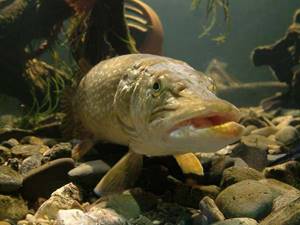
Metal leashes, guitar string leashes, and fluorocarbon leashes can be used as leashes. Some anglers use leashes made from thin telephone cable wire. They are well suited for playing with lures from 5 to 10 cm. Although they break quickly, you need to be careful and change the leashes when bending and after each fish caught. But they are light and do not change the game of the bait even with a length of 25 cm. You can pull out a trophy up to 5 kg on such leashes.
You also shouldn’t throw away baits such as spoons from your arsenal; they have long been considered proven baits when catching predators. These are such old baits as “Atom”, “Playing”, “Senezh”, “Yenisei”, “Uralka”. Or their new analogues:
Pontoon21 Sabetta,
Sampliora,
Sintura,
Soft plastic baits work just as well, both with and without weights. That's all, write your comments, whether you liked the article or not, what you can add about this. Now watch the video on how to catch pike in the spring:
Now for the weekly crossword, click Solve Crossword.
To Home Page.
Using nets when fishing for pike
The net remains an extremely popular fishing tool, since the abundance of cheap Chinese products does not require weaving them yourself, and even without special skills you can count on a good catch. This works well for a variety of white fish, but net fishing for pike is not so easy. The toothy predator is usually dispersed throughout the reservoir, and is mostly inactive, as it hunts from ambush. In this regard, pike are caught in nets relatively rarely.
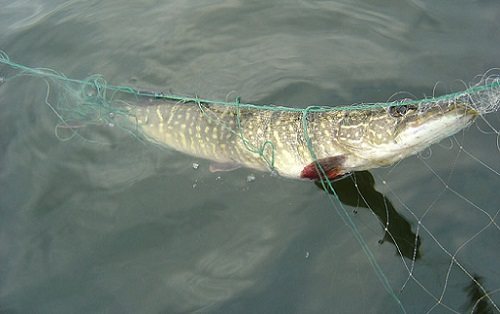
How to choose a place for fishing for pike with a circle?
In order to count on a good catch, you should pay attention to choosing the most suitable place.
Among the main recommendations we note the following:
- In spring, the predator often lives close to the spawning site, for example, in shallow shallow depressions where the water warms up well.
- Some time after spawning, the fish move to riffles and holes, biting almost constantly.
- In summer, the fish are constantly on the move and often make ambushes near pits. During this period of the year it is quite easy to notice, as it can jump out of the water.
- In the autumn period, activity becomes greater; with the onset of cold weather, the predator goes deeper and becomes more voracious.
As a rule, the predatory fish in question often seeks shelter from which it can quickly and quietly attack its prey.
Mesh size and tactics
The net for pike fishing is selected based on fishing conditions and the expected size of the prey. For small rivers, where the size of a toothy predator rarely exceeds one or two kilograms, a 40 mm mesh is quite sufficient, but in places where a decent-sized predator is often encountered, it is necessary to use options from 60 to 80 mm. Large-mesh nets are especially often used on Siberian rivers. However, you should not use options that are too large and thick. The mesh pattern of too coarse gear can scare away predators, especially in clear water.
The choice of installation location largely depends on the size and characteristics of a particular reservoir. It’s easier if the river or pond is already familiar from spinning or feeder fishing - you already have a rough idea of where fish are concentrated and the usual routes of their migration. Otherwise, there is a chance of getting a lone pike accidentally caught in the net. There are also differences depending on the season. In the spring, the net is often placed with a slope of 45 degrees in depth; at the same time, you can try to cover the detected anomaly of the bottom topography, since in such places fish often rise from the depths.
Spring
Let's find out which nets to catch pike in the spring. The so-called “path” is rightfully considered one of the most productive options at this time of year. It allows you to block a section of the river at a certain depth, and the catchability of such gear is ensured by the seasonal behavior of the pike. At the very beginning of spring, this fish begins to prepare for spawning - it rises upstream of the river, in search of shallow waters suitable for spawning, which will be formed during the flood. Anglers take advantage of this movement, blocking the river in several places where pike paths pass. However, it is precisely at this time that nets can cause the greatest damage to aquatic life.
At the same time of year, in sections of rivers where a significant number of pike accumulate, mesh lines, as well as other types of trap nets, are also effective.
Summer fishing
Fishing for pike in summer requires a slightly different approach. The probability of a toothy predator getting into the same “path” at this time of year is significantly lower, so you have to use slightly different tactics. Double-walled and three-walled nets are used, into which the fish are literally driven by the fishing participants. The net is installed in front of the reed growth line, and then the pike is driven into the net by hitting the water with special devices.
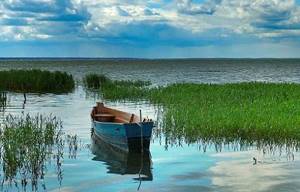
To hit the water, they use either a cunningly shaped wooden device like a quok, used when catching catfish, or they use a simpler product - the cut off neck of a plastic bottle, put on a stick. Impacts on the water force the pike to leave its favorite ambush spot, and this method of fishing works most actively not against a hunting pike, but against a pike that is already well-fed.
Lures for catching pike in spring
When fishing for large pike, it is almost always wise to use large lures. They are more visible in the water and create powerful vibrations, to which a predator reacts from afar. This is advisable throughout the summer, and especially autumn. But in early spring you shouldn’t chase size. The fish have not yet fully awakened from winter, are in a rather passive state due to the low water temperature, their metabolism is reduced, and they do not require much food. The water immediately after the opening of the reservoir is still quite clear, and even a small bait will be clearly visible from afar. Use medium-sized silicone from 7-12 cm when searching for a trophy. To catch grass and small pike from the shore, you can further reduce the size.
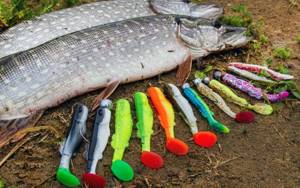
Using networks in winter
Nets are also used in winter. Targeted fishing for pike is usually not carried out at this time of year, but it is often caught as bycatch. It is important to consider that not every body of water is suitable for such fishing. It must be either a fairly large river or a large pond with great depths. Particular attention should be paid to the cleanliness of the bottom - if the river is littered with various debris, submerged trees or boats, then frequent breaks of gear cannot be avoided.
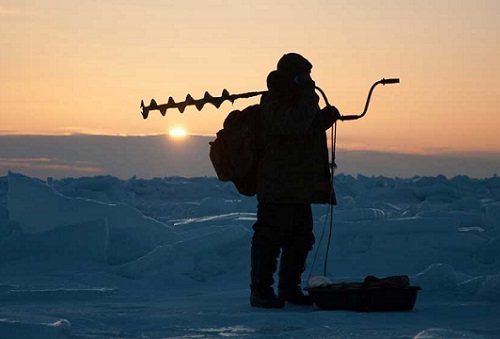
Installing a net in winter is more complicated than in the open water season, and requires both a large number of participants (the longer the net, the more) and additional devices. The installation process itself looks like this:
- Snow is removed from the ice in the places where fishing will be carried out, two main ice holes are prepared, between which several smaller ones are drilled at a distance of 3-4 meters - they will be needed in order to install and, if necessary, correct the net.
- A special rope is pulled through the top of the net, using which the net will be pulled under the ice.
- The end of this rope is tied to a long, even pole, through which the net will be stretched under the ice from hole to hole.
- The lower edge must be covered, otherwise it will not be able to straighten out correctly and perform its task properly.
- In the holes drilled between the main ones, the net is fixed to the sticks so that its upper edge does not touch the ice, otherwise it may freeze into it, which can lead to damage to the gear.
There are alternative, somewhat simpler ways to set up nets under the ice. A more expensive device, but one that greatly facilitates the installation of gear, is the so-called “torpedo”. The device is equipped with a fairly powerful electric motor, as well as bright LED lights that allow you to determine the location of the device under the ice.
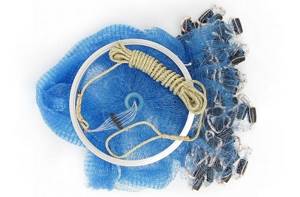
RusCamping - exchange of experiences and opinions
Review and recommendations for fishing with feeder-trap gear.
Now there are many offers on the Internet for the sale of a small net with a feeder , which can be cast either manually or using a spinning rod. At the same time, fish swimming up to the feeder and swimming around the bait should theoretically become entangled in this net. How to fish with this gear is not described in detail anywhere. It is only reported that you need to press complementary food into the spring feeder (a special mixture for bait or just millet or pearl barley porridge) and throw the tackle into shallow water and wait for the “bite”.
minigrid with feeder Chinese version
Since the design of the tackle is simple, you can make it yourself using a feeder and a piece of net fabric about 1.5 meters in size, or buy it from the Chinese via the Internet, where its cost ranges from 30 to 80 rubles per piece.

net trap-feeder with a catch, the promised catch - American advertising.
There are a lot of opinions about this net, but one thing is for sure, with a fairly compact size, it combines the delights of fishing with biting, while the catch does not depend on the intensity of the fish’s hunger - the fish can only be caught by coming up to sniff the complementary food, while whether bait on a hook on a regular fishing rod - maybe she wouldn’t swallow it.
What kind and how many fish can you catch with this feeder-trap or as it is now called - FindFish?
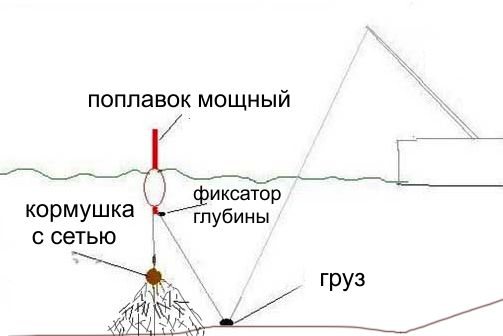
Russified instructions for fishing with a mininet with a feeder The principle of fishing with a net with a feeder is not similar to a fishing scarf, but therefore the efficiency here is higher, since, unlike the wall of a scarf, this net catches in any direction - the fish will not pass along the canvas. The mesh is not loaded, sewn in the shape of a cone, used fluffed, i.e. it creates a net volume in which the fish feed on the food falling out of the feeder. In summer, the feeder can be equipped with a float and cast from the shore, in winter into a hole (see diagrams below). When fishing from ice, a net with a feeder is lowered into the hole to the bottom, and then raised by about 50 centimeters and left in this state, waiting for fish to fall into it. For sportiness, you can put it on a nod made of ordinary willow rod.
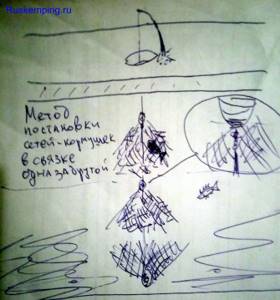
method of placing in a bundle vertically
Another way to install feeder nets is to place them in a bunch one above the other - the number depends on the depth of the reservoir. The length of the tackle can be increased directly on the water by attaching one feeder-trap to another. With this setup, the lower feeder with the net lies on the bottom, the rest are located at half-water and the upper one is almost on the surface. This installation option is also good because from the first fish caught you can understand at what level in the water column the fish is kept.
A predator often gets caught in such a net with a feeder, as it hunts for fish that feed near the feeder. To prove this, you can watch video reviews on our website, where you can see how both perch and pike perch are caught in the gear.
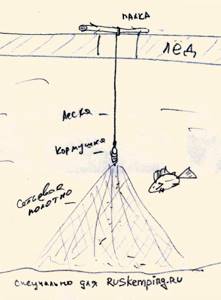
installation diagram of a mini-grid with a feeder under ice
Findfish feeder trap - where to buy, how to catch it and how to make it yourself.
By the way, of course, it’s easier to buy such tackle rather than make it yourself, but making it yourself is also not difficult at all - we make a springy feeder, which we fill with complementary foods and tie a piece of net fabric about a square meter in size to a swivel attached to its bottom.
Experience of use has shown that the effectiveness of this gear can be compared to all known fishing scarves. You can also fish with these nets and feeders in winter . The net with the feeder is lowered into the hole to the bottom, and then raised by about 40 centimeters and left in this state, waiting for a fish to fall into it. Among the inconveniences of winter fishing, it should be noted that before lowering the tackle into the hole, its edges must be almost perfectly cleared of ice, otherwise a lump of net will cling to it and in this situation it will be difficult to drown the net.
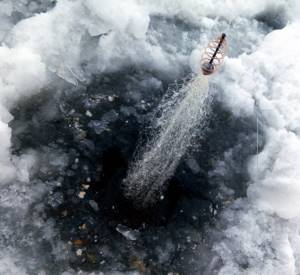
photo of a net with a feeder when fishing from ice in winter

catch - fishing in winter
Of the gear I know, it reminds me of the good old “pioneer” - a roll of netting with a piece of white foam, which was thrown into the water on a rope, the fish, thinking that it was food (bread for example), swam up to it to look and got tangled in the net, at that moment it was pulled out . Used mainly for catching bleak.
In the photo on the right is my catch in a net with a feeder on the first ice - I put one in for testing - in 3 hours I caught 1 crayfish and 3 good roaches!
Conclusion: a mininet with a feeder has its advantages in terms of compactness and an element of sportiness - a “bite” can be seen, an element of descent may be present. Good maintainability. Efficiency is very average. In addition, it should be recalled that the tackle is, of course, poaching.
I bought it by mail here https://ali.pub/27irhe for about forty rubles apiece in a batch of 4 different sizes of yak. Sent very quickly. Although you can make such a feeder-trap with your own hands, in my opinion it’s easier to take a ready-made one. Well, given the cheap price, take at least a dozen - then fishing will definitely be more fun.
As an option, such a mesh feeder can also be supplemented, for example, with a baby bird, as in the video below. Then, when catching live bait, you can additionally please yourself with a larger fish, which, as a rule, usually always manages to escape when the little fish rises...
Poscriptum . Fishing practice with a feeder net. Personal experience using a mesh feeder.
After playing with these devices a few times, I actually somehow abandoned them... But just last week we were fishing for bream - the bite was very bad - there was a feeling that the little thing was eating the bait, or the fish was very carefully trying what was on the hook...
I accidentally discovered 3 net traps in my backpack. I decided to try it.
I filled the feeders with porridge and lowered them to different depths: one net with a feeder at the bottom, the rest a meter higher. And... lo and behold! First one twitched, then the other! I'm dragging - a decent sapa! Then 8 saberfish flew into the nets at once. As a result, in half an hour I caught about 4 kilograms of fish. During the same time, I managed to catch only one bream on the bottom. So the tackle, as I said above, can perform well under certain conditions!
If necessary, I will film and post a video here with instructions on how to fish correctly with such nets and feeders! Although there are actually a lot of them on YouTube - they mostly fish with a fishing rod or spinning rod - in open water and in a hole - in winter.
I’m glad if you liked the material on the site and the article!
Casting networks
Although this variety is intended primarily for catching schooling fish species, it is possible, however, in a similar way, naturally with the proper skill, since this version of the net is more difficult to master, to catch toothy predators. To do this, you need to know well the favorite spots for pike. The technique for using the casting network is as follows:
- First of all, the tackle must be properly folded, because nothing should prevent it from turning around during the throw. The traction rope is folded on the hand, and you need to watch carefully so that no loops form on the cargo rope.
- The net is intercepted by the upper part and rolled up on the hand in several loops (their number depends on the size of the gear used).
- With several swinging movements, or with one fairly sharp one, the casting net is thrown onto a pre-selected area of the reservoir.
- Thanks to the weight, the net quickly sinks to the bottom, and all that remains is to pull it out by the rope attached to the base.
Fishing this way is interesting, but you most likely won’t be able to catch something immediately after purchasing the gear; it will take a lot of time to master it.
Pike fishing will be discussed in the video:
Fishing with nets
Fixed nets are not used specifically for pike fishing: the predator is too scattered throughout the reservoir, too often leads a sedentary lifestyle - a short throw for prey and return to ambush. The spring concentration of pike occurs in places where it is much more convenient to use not nets, but meshes and other trapping gear. In general, in a net with a mesh suitable for catching it, pike is caught by chance, as bycatch.
Pike are generally caught in floating nets (floated downstream with a boat or between two boats) in exceptional cases.
However, pike often attacks fish caught in a single-walled (gill) net for catching small fragmented fish, the most common in Russian reservoirs - that is, perch and roach (amateurs use single-walled nets with a mesh of 27–32 mm to catch them). Sometimes the matter ends with the capture of a predator (usually small, weighing up to 1 kg). Moreover, the pike does not mesh as it should - the mesh is too small for it, but it gets caught in a rather sophisticated way: having caught on the net with bony protrusions on its lower jaw, it begins to fight and wraps a nearby section of the net around itself, forming something like a cocoon. Very often, if the predator has time, it slips out of this cocoon - and if the fisherman checks the net at the very end of the release process, he will be surprised to find a pike held only by the tail by the net wound around it. If you are late, you can only find the notorious cocoon of tangled fish, richly saturated with pike mucus.
Large pikes are not caught in this way - having grabbed a roach or perch entangled in a net, they easily tear the thin fish with their teeth and leave only a hole in the net as a souvenir of their visit.
Not so long ago in Finland, a net was invented and patented for catching pike and other large predators - not schooling ones, roaming alone in a reservoir. Moreover, the bait should be small fish entangled in the gear.
Specific pike fishing tactics
But, apparently, precisely because of the small area of the reservoir, the predator is extremely cautious, after all, one shore is located not far from the other, and where else can the fish expect danger from the shores. Therefore, the tactics for catching pike are specific. If you lower the live bait closer than 10 meters from you and sit next to the fishing rod at the water’s edge, then most likely you won’t get a bite. In any case, this was not the case for me. Apparently, the pike sees (despite the camouflage duckweed) the fisherman or senses him in an incomprehensible way, and only inexperienced pike fish are likely to bite. By the way, for some reason all kinds of “pencil laces” stay apart from adult pikes; at least, they have never been found mixed up in one place. But let's return to fishing tactics.
I usually use two options
If conditions permit (sufficient amount of duckweed-free water, absence of strong side winds), then I cast the rig along the canal at a distance of 10-15 meters. After casting, I wait about 10 minutes for a bite, no more. At this time, I don’t stomp around on the shore, I don’t make noise, I sit quietly and wait. No bites - I change place. Sometimes casting along the shore is impossible, and fishing after a bite seems difficult - there are a lot of algae that interfere with this matter. But if the place is cool, then I try to catch it. I cast not far in front of me and move a few meters away, hiding behind the grass, trying to make sure the float is clearly visible. The rod lies on a stand, the butt for belay is pressed against a heavy stone or a wooden spear. I act this way, knowing that I have already scared off the pike and it has moved away. However, soon the predator will probably appear here again, because this is her personal territory. But how long does it take for her to finally calm down? Sometimes it comes after 10 minutes, sometimes even after half an hour. Therefore, when casting close, I wait 30-40 minutes, and only then change the place. But during this time I do not break strict camouflage for a second (neither audio nor visual - I sit quietly, like a mouse). And only when there is a confident bite I rush to the rod.
